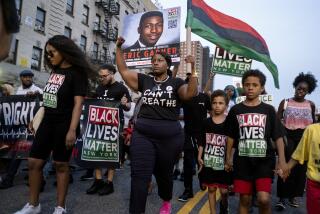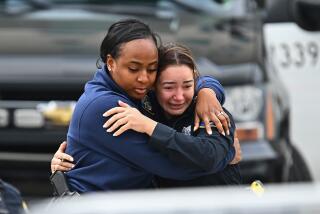Baltimore man died of spinal injury that occurred while in police custody

Demonstrators protest the death of Freddie Gray outside Baltimore City Hall on Monday.
Freddie Gray died from injuries sustained while in Baltimore police custody, an autopsy confirmed Monday, but how his spine was nearly severed and what role, if any, officers played remained a mystery.
Mayor Stephanie Rawlings-Blake and Police Commissioner Anthony W. Batts called for calm to allow police to complete their investigation. Protests have remained peaceful.
“We are a community on edge right now,” Batts told reporters. “We hear, I hear, the outrage. I hear the concern and I hear the fear.”
Gray, 25, died Sunday, a week after he was arrested and placed in a police van.
An officer pulled out a Taser during the arrest but did not deploy it, Batts said.
“When Mr. Gray was put in that van, he could talk and he was upset,” Deputy Police Commissioner Jerry Rodriguez said during a televised news conference. “When he was taken out of that van, he could not talk and he could not breathe.”
William H. “Billy” Murphy Jr., an attorney for the dead man’s family, said that sometime during Gray’s arrest, “his spine was virtually severed, 80% severed, in the neck area.” Murphy accused police of hiding information related to the arrest “until they develop a version of events that will absolve them of all responsibility.”
In releasing details of the autopsy, authorities confirmed at least part of the family’s charges.
Gray “did suffer a significant spinal injury that led to his death,” Rodriguez said. Exactly where and when the injury took place remain the focus of the investigation, which is expected to take until May 1. The results will be turned over to prosecutors. Six officers have been suspended.
The incident began about 8:40 a.m. on April 12. Gray was arrested after fleeing “unprovoked upon noticing police presence,” according to charging documents first reported by the Baltimore Sun. Police said they found a knife clipped to the inside of Gray’s front pants pocket and placed him under arrest.
Official documents describe him as about 5 feet 8 and weighing about 145 pounds.
“The defendant was arrested without force or incident,” Officer Garrett Miller wrote in the charging documents. “During transport to Western District via wagon transport, the defendant suffered a medical emergency and was immediately transported to Shock Trauma via medic.”
The family has questioned officers’ grounds for approaching Gray.
At the news conference, Rawlings-Blake acknowledged the complaint. “We know that having a knife is not necessarily a crime,” she said, calling it “not necessarily probable cause.”
Also Monday, police released the latest timeline and a new video taken by a closed circuit camera that was panning the street where the arrest took place.
At 8:46 a.m., about four minutes after Gray had been put in a police van, the driver believed Gray was acting “irate.” The van stopped, and Gray was put in leg irons and returned to the van, police said. Another video caught that scene, but did not show what happened inside the vehicle.
The van made several stops on its way to the police station, even picking up another prisoner in an unrelated case after Gray had asked for medical attention several times, police said. He had requested an inhaler but did not receive one. The prisoners were separated from each other by a metal barrier in the back of the van, which had no camera, police said.
A medic was called for Gray by 9:24 a.m.
Something must have happened between the time Gray was videotaped and the time he arrived at the police station in deep distress, Rodriguez said.
“We know the injuries Mr. Gray sustained. We know the outcome,” Rodriguez said. “What we don’t have at this point is how Mr. Gray sustained those injuries.”
Batts said he had ordered the department to rewrite police rules on moving suspects and how to respond to medical emergencies.
The Baltimore Sun contributed to this report.
More to Read
Start your day right
Sign up for Essential California for news, features and recommendations from the L.A. Times and beyond in your inbox six days a week.
You may occasionally receive promotional content from the Los Angeles Times.







